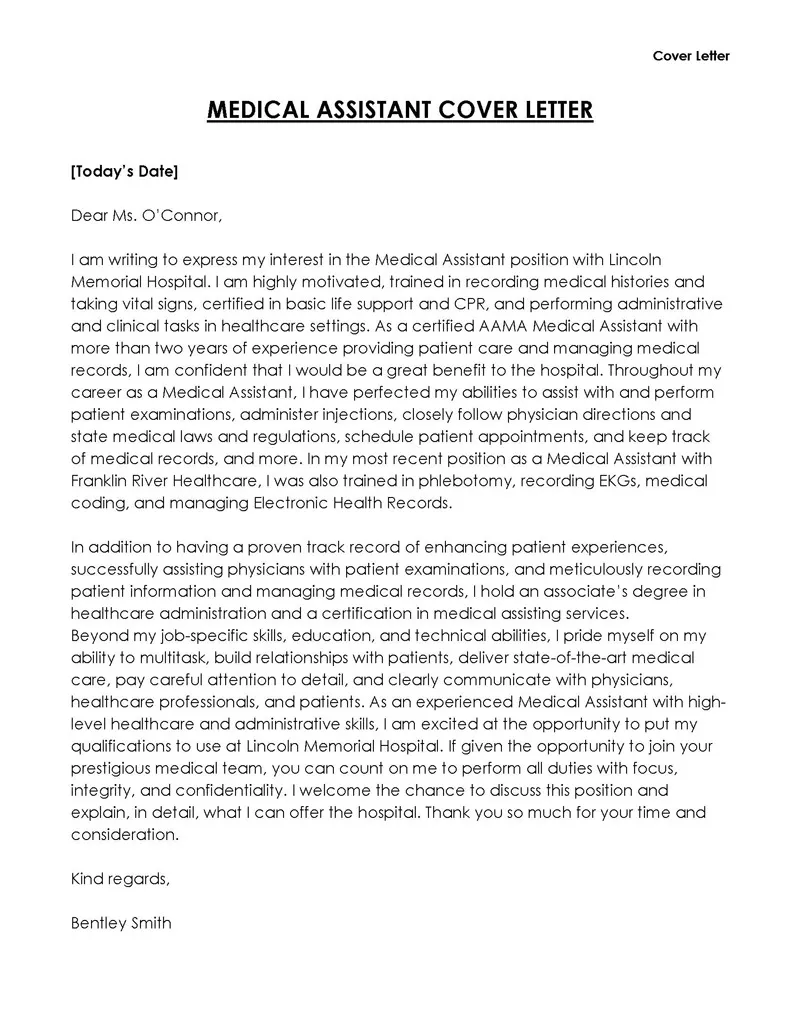Crafting Your Medical Assistant Cover Letter
A compelling cover letter is your first opportunity to make a strong impression and secure a medical assistant position. It’s more than just a formality; it’s a crucial marketing tool that showcases your skills, qualifications, and enthusiasm for the role. With the increasing competition in the healthcare job market, a well-crafted cover letter can set you apart from other applicants and significantly increase your chances of landing an interview. This guide will provide you with all the necessary tools and insights to create a cover letter that grabs the attention of hiring managers and highlights your suitability for the job. Remember, your cover letter is a reflection of your professionalism and attention to detail, so it’s essential to invest time and effort in crafting a document that truly represents you.
Highlighting Your Skills and Qualifications
As an entry-level medical assistant, you may not have extensive professional experience. However, your cover letter should focus on the skills and qualifications that make you a strong candidate. Identify the key requirements listed in the job description and tailor your letter to address them. Highlight relevant coursework, volunteer experiences, or any other experiences that demonstrate your abilities. Medical assisting roles require a blend of technical skills, such as taking vital signs and assisting with examinations, and soft skills, such as communication and empathy. Make sure your cover letter addresses both aspects, providing specific examples of how you have demonstrated these skills in the past. Use action verbs to describe your accomplishments and skills, making your letter more engaging and impactful. For example, instead of saying ‘I am good at multitasking,’ say ‘Effectively managed multiple tasks simultaneously.’ Be as specific as possible, providing concrete examples to support your claims.
Education and Certifications
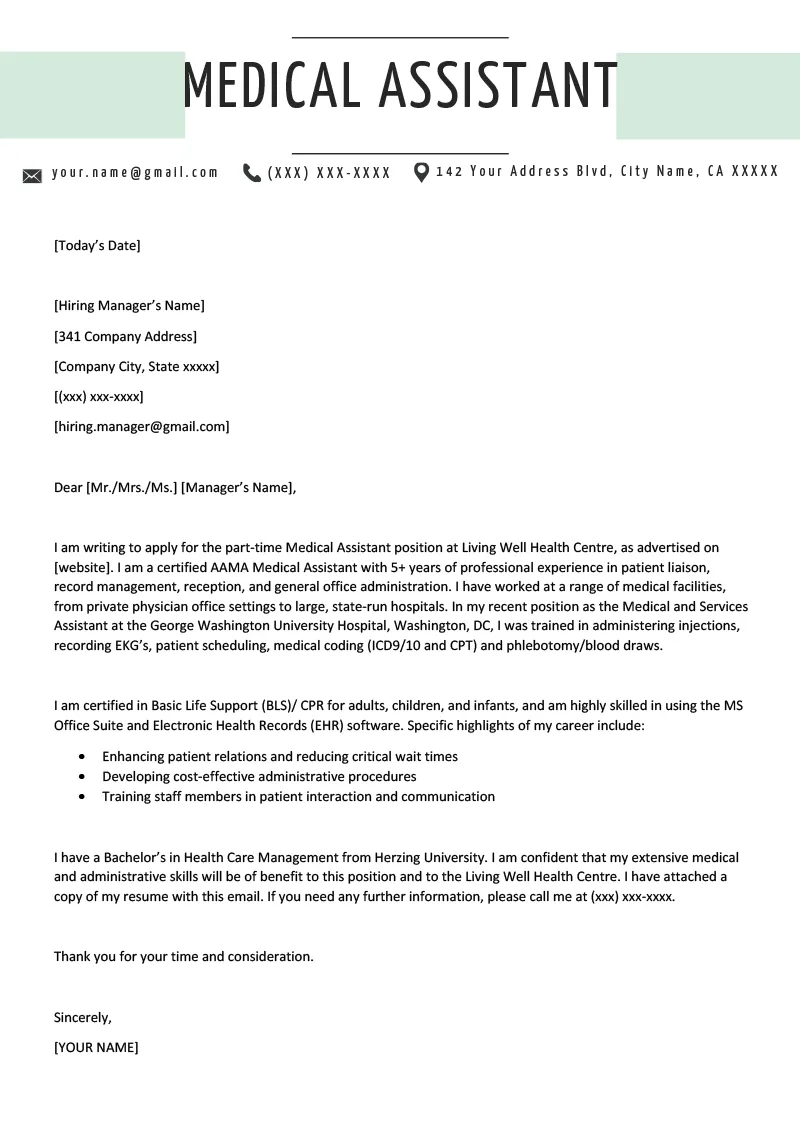
One of the most important sections of your cover letter is where you highlight your education and certifications. Medical assisting roles often require specific certifications, such as the Certified Clinical Medical Assistant (CCMA) or the Registered Medical Assistant (RMA). Clearly state your certifications and any relevant training you’ve completed. Include the name of the institution where you received your training and the date of completion. If you’re currently pursuing certification, mention the expected completion date. Additionally, describe any related coursework or academic achievements that demonstrate your knowledge and understanding of medical assisting principles. For instance, if you’ve taken courses in medical terminology, anatomy and physiology, or pharmacology, mention them. Also, highlight any honors or awards you received during your education. Your education and certifications are the foundation of your qualifications, so make sure this information is easy to find and clearly presented.
Clinical Skills
Describe any clinical skills you possess. Even if you’re an entry-level candidate, you may have gained some clinical experience through your education or volunteer work. Some examples include taking patient histories, measuring vital signs (blood pressure, temperature, pulse, and respiration), assisting with examinations, and preparing examination rooms. If you’ve had experience with phlebotomy or administering injections, be sure to mention it. Highlight any experience you have with electronic health records (EHR) systems. Many medical facilities use EHR systems for patient documentation and record-keeping. Showcasing your familiarity with these systems can make you an attractive candidate. Avoid technical jargon and explain your skills clearly and concisely. The goal is to demonstrate your ability to perform the essential clinical tasks required of a medical assistant. Be honest about your skill level and focus on what you can confidently do.
Communication and Interpersonal Skills
Communication and interpersonal skills are essential in medical assisting. Medical assistants interact with patients, physicians, and other healthcare professionals daily. Your cover letter should highlight your ability to communicate effectively, both verbally and in writing. Describe your experience interacting with patients, including your ability to explain medical procedures, address patient concerns, and provide emotional support. Explain how you’ve handled difficult situations or conflict. Provide examples of your empathy, compassion, and ability to build rapport with patients. Good communication involves active listening and the ability to understand and respond appropriately to the needs of others. Also, describe your ability to work as part of a team and collaborate with other healthcare professionals. Mention any experience you have in coordinating patient care, scheduling appointments, or managing patient records. Focus on demonstrating your ability to create a positive and supportive environment for both patients and colleagues.
Showcasing Relevant Experience
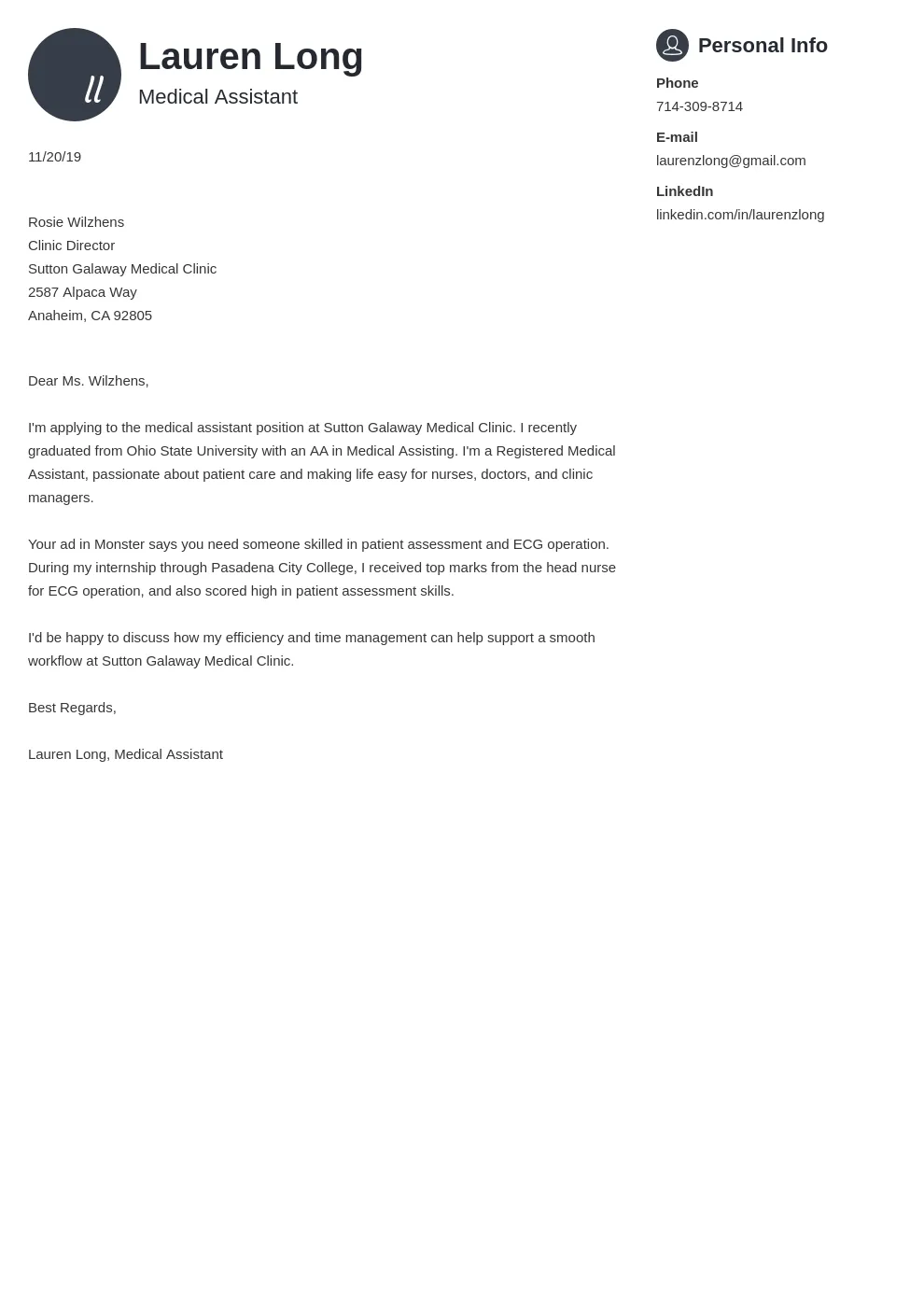
Even if you’re an entry-level candidate, you likely have some relevant experience to highlight. This could include volunteer work at a clinic or hospital, shadowing a medical professional, or participating in a medical assisting program. When describing your experience, focus on the tasks you performed, the skills you developed, and the impact you had. For instance, if you volunteered at a clinic, describe the tasks you performed, such as greeting patients, answering phones, or assisting with administrative tasks. Highlight any opportunities you had to interact with patients or observe medical procedures. If you shadowed a medical professional, explain what you learned from the experience. Show how your experience aligns with the job requirements. For example, if the job description emphasizes patient communication, highlight your experience in interacting with patients and addressing their concerns. Quantify your achievements whenever possible. For example, instead of saying ‘Assisted with patient intake,’ you could say ‘Processed an average of 20 patient intakes per day.’ Providing concrete examples makes your experience more tangible and demonstrates your skills more effectively.
Addressing the Employer’s Needs
Always tailor your cover letter to the specific job and employer. Carefully read the job description and identify the key requirements. Then, address these requirements in your cover letter, explaining how your skills and experience align with the needs of the employer. Research the clinic or practice to understand its mission, values, and the type of patients it serves. This will help you tailor your cover letter to the employer’s specific needs. For instance, if the job description emphasizes experience with electronic health records, highlight your experience with such systems. If the employer mentions a focus on patient care, emphasize your interpersonal skills and your ability to build rapport with patients. Address the employer’s needs directly and explain how you can contribute to their success. Remember, the goal is to show the employer that you’re a good fit for their organization and that you understand their requirements. Personalizing your cover letter demonstrates your interest in the specific opportunity and shows you’ve taken the time to research the role and the employer.
Researching the Clinic or Practice
Before you start writing your cover letter, research the clinic or practice. Understanding their mission, values, and the types of patients they serve will help you tailor your letter to their specific needs. Visit their website, read online reviews, and see if you can find any information about the practice’s culture or environment. This research will allow you to show that you have a genuine interest in the organization. Use keywords from their website or job description to highlight how you match their requirements. If the clinic emphasizes patient care, highlight your interpersonal skills and experience interacting with patients. If they focus on specialized medical services, tailor your cover letter to showcase your related skills or training. Knowing about the clinic’s values allows you to align your skills and experiences to their goals. Demonstrating you understand the organization can increase your chances of getting noticed and selected for an interview.
Tailoring Your Cover Letter
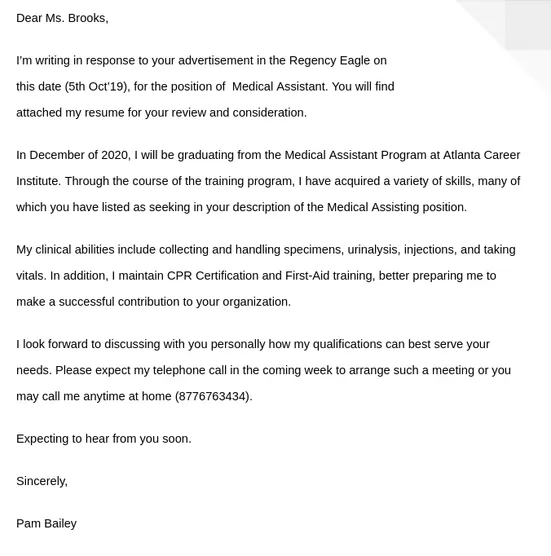
Avoid using a generic cover letter. Instead, tailor each letter to the specific job and employer. Customize your cover letter to match the requirements listed in the job description and highlight the skills and experiences that are most relevant. The best way to do this is by carefully reading the job description and identifying the key requirements. Then, address these requirements in your cover letter. Make sure to use the same keywords and phrases that are used in the job description. If the job description emphasizes a certain skill, such as phlebotomy or electronic health records, be sure to highlight your experience in this area. If possible, research the clinic or practice to understand their specific needs and values. Use this information to tailor your letter and show the employer that you’re a good fit for their organization. Personalizing your cover letter demonstrates that you’re genuinely interested in the opportunity and that you’ve taken the time to learn about the role and the employer. Remember, employers can easily spot generic cover letters, so customization is crucial to stand out.
Formatting and Structure
A well-formatted cover letter is easy to read and demonstrates your attention to detail. Use a professional font, such as Times New Roman, Arial, or Calibri, and keep the font size between 10 and 12 points. Use 1-inch margins on all sides of the page and single-space your text, with a double space between paragraphs. The structure of your cover letter should follow a standard format. Start with your contact information, the date, and the employer’s contact information. Then, include a formal salutation, such as ‘Dear Mr./Ms. [Last Name].’ The body of your cover letter should be divided into three to four paragraphs. The opening paragraph should state the purpose of your letter and express your interest in the position. The body paragraphs should highlight your skills, qualifications, and relevant experience. The closing paragraph should reiterate your interest in the position and include a call to action. Maintain a consistent format throughout the letter, and ensure your writing is clear and concise. A well-formatted and structured cover letter shows that you are organized and professional.
The Opening Paragraph
The opening paragraph should immediately capture the reader’s attention. Start by stating the purpose of your letter and mentioning the specific position you’re applying for. You can also include where you saw the job posting. Then, express your interest in the position and briefly explain why you’re a good fit. Avoid generic openings like ‘I am writing to express my interest…’ Instead, try to be more engaging. You can start by mentioning something specific about the company or the role that caught your interest. For example, you could mention the clinic’s reputation for patient care or a specific skill that is required. Make your opening paragraph concise and to the point, and be sure to show your enthusiasm for the opportunity. The goal is to encourage the reader to continue reading the rest of your letter. A strong opening paragraph sets the tone for the entire letter and motivates the reader to learn more about you.
The Body Paragraphs
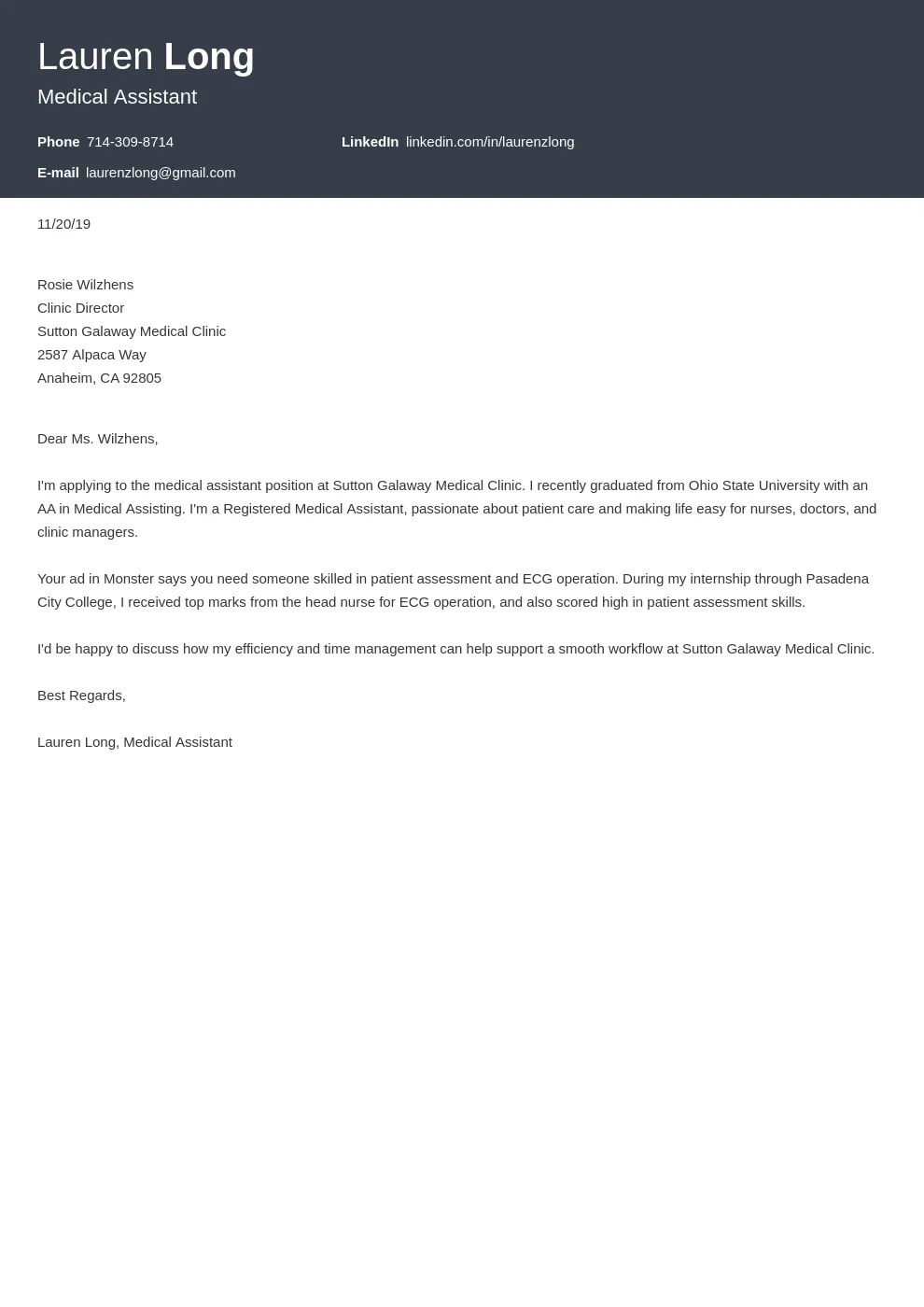
The body paragraphs are where you provide details about your skills, qualifications, and relevant experience. Use these paragraphs to showcase your accomplishments and explain why you are the best candidate for the job. The length should be appropriate for the space, and it should include concise details. Use strong action verbs to describe your accomplishments. Instead of just listing your responsibilities, provide specific examples of what you achieved. Quantify your accomplishments whenever possible. Provide data or numbers to illustrate the impact you had. Make sure to address the key requirements of the job description. Highlight the skills and experiences that align with the employer’s needs. If the job description mentions specific skills, such as phlebotomy or electronic health records, make sure to mention them in your body paragraphs. Tailor your content to the specific role and make sure you demonstrate how you would contribute to the team. This is the section where you convince the employer that you are the right fit for the job.
The Closing Paragraph
The closing paragraph should reiterate your interest in the position and thank the employer for their time and consideration. Restate your enthusiasm for the opportunity and briefly summarize your qualifications. Then, include a call to action, such as encouraging the employer to contact you for an interview. Make sure to provide your contact information again, in case it is not visible at the top of the letter. Close your letter with a professional closing, such as ‘Sincerely’ or ‘Best regards,’ followed by your name. Proofread your entire cover letter carefully to make sure it is free of errors. Ensure the closing paragraph leaves a positive and lasting impression. It’s the final statement about you, so make it count. Always thank the employer for their time and express your eagerness to learn more about the role and the company.
Call to Action
A call to action tells the employer what you want them to do next. Encourage the employer to contact you for an interview by stating your availability for an interview. You can provide your phone number and email address again in the closing paragraph. Be specific and confident in your call to action. Instead of a generic closing, write something like, ‘I am eager to discuss how my skills and experience can benefit your team. I am available for an interview at your earliest convenience.’ Make it easy for the employer to take the next step. Make sure you are ready to follow through with your call to action by being prepared to respond to interview requests promptly. A clear call to action shows you’re proactive and eager to move forward in the hiring process. Ensure your contact information is accurate and up to date, so the employer can reach you easily.
Proofreading and Editing
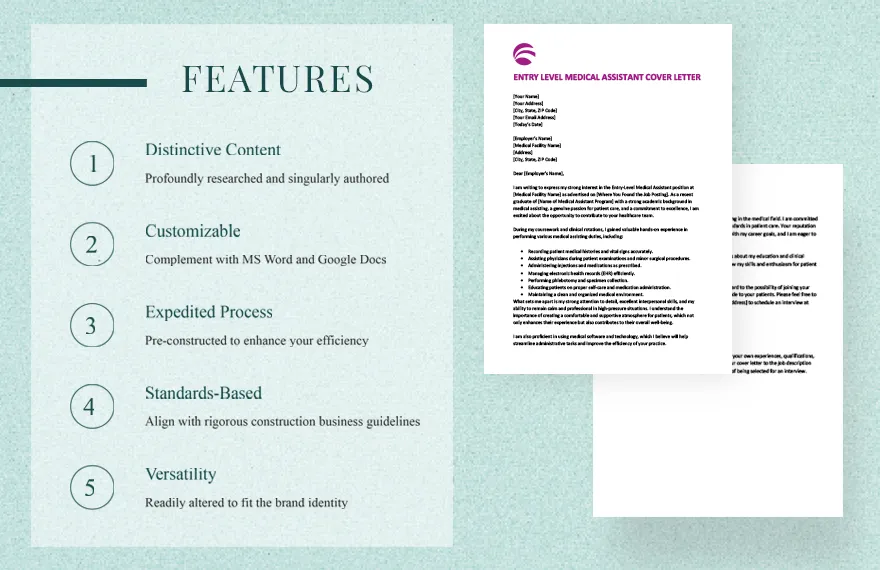
Proofreading and editing are essential steps in creating a professional cover letter. Errors in grammar, spelling, and punctuation can create a negative impression and undermine your credibility. Carefully review your letter for any mistakes, including typos and grammatical errors. Read your cover letter multiple times, ideally reading it aloud, as this can help you catch errors. Check your writing for clarity and conciseness. Make sure your sentences are clear, and your ideas are well-organized. Ask someone else to proofread your letter. A fresh pair of eyes can often spot mistakes that you might miss. Consider using a grammar checker tool or software to identify potential errors. Review the final version of your cover letter carefully before submitting it. A polished and error-free cover letter shows that you pay attention to detail and are professional. Take your time and make sure your cover letter reflects your best work.
Common Mistakes to Avoid
Avoiding common mistakes is crucial to creating an effective cover letter. There are several pitfalls that can damage your chances of getting an interview. Avoid these common errors to make the best impression and increase your likelihood of securing the job. Make sure to avoid mistakes such as generic language or focusing too much on yourself. Also, make sure that you proofread.
Using Generic Language
Using generic language is one of the biggest mistakes you can make in a cover letter. Generic cover letters that could apply to any job do not stand out. They do not show a genuine interest in the specific position. Avoid using phrases that are overused or cliché, such as ‘I am writing to express my interest…’ or ‘I am a hard worker…’ Instead, use specific and compelling language that highlights your skills and qualifications. Mention specific experiences and accomplishments. Use action verbs to describe your skills and duties. Tailor your language to match the job description and the employer’s needs. Using specific examples and quantifiable achievements makes your cover letter more engaging and memorable. Avoid writing a generic cover letter; make your letter unique and customized for the role.
Focusing on Yourself Too Much
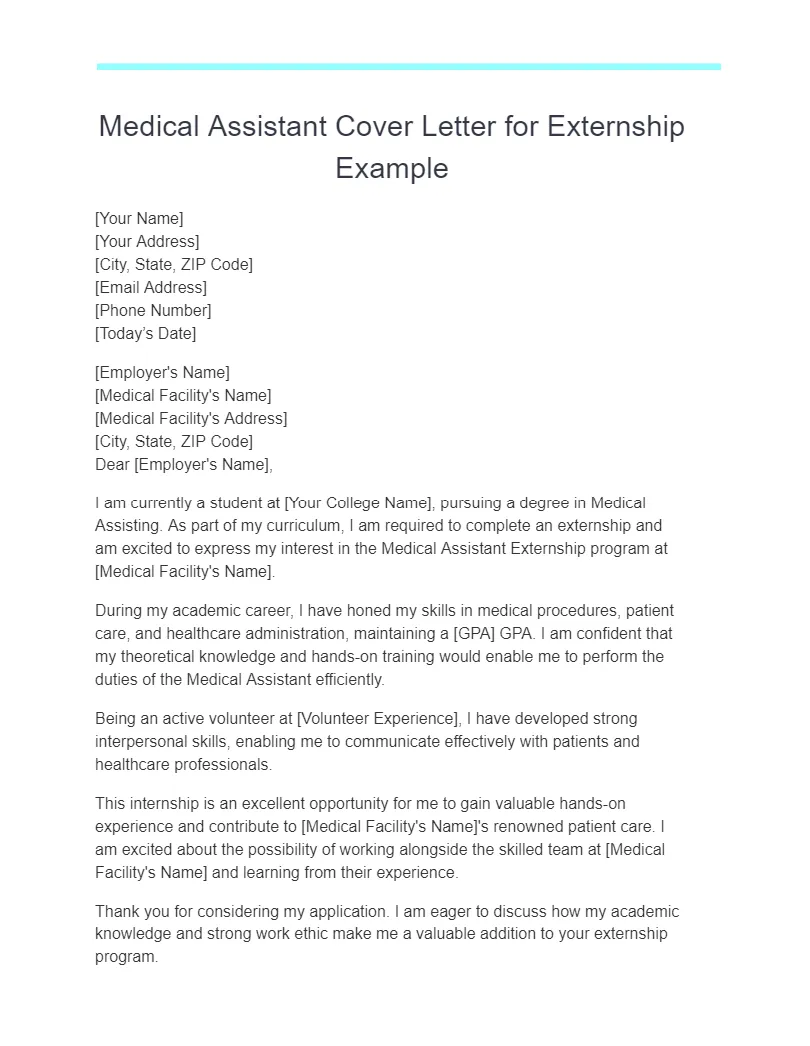
While your cover letter should highlight your skills and experience, avoid focusing too much on yourself. The focus should be on how you can benefit the employer and contribute to their organization. Frame your accomplishments in terms of the value they bring to the employer. Show how your skills and experience align with the employer’s needs and how you can help them achieve their goals. Emphasize what you can do for them, not just what you want. Include examples of past achievements and skills. Use action verbs to describe your skills and accomplishments. Tailor your cover letter to the employer’s specific needs and explain how you can address them. Remember, the employer is looking for someone who can solve problems and contribute to their success. Show them how you can do that.
Neglecting to Proofread
Neglecting to proofread your cover letter is a common mistake that can significantly hurt your chances. Typos, grammatical errors, and spelling mistakes can create a negative impression and make you look unprofessional. Proofread your cover letter carefully before submitting it. Read your letter multiple times, and ideally read it aloud. Ask someone else to proofread your letter. A fresh pair of eyes can often spot errors that you might miss. Use a grammar checker tool to identify potential mistakes. Pay close attention to details, such as punctuation, capitalization, and sentence structure. Ensure that your letter is error-free and professional. A well-proofread cover letter demonstrates your attention to detail and commitment to quality. Always take the time to proofread your cover letter to avoid making this common mistake.
Best Practices for Your Cover Letter
Following best practices will help you create a cover letter that stands out and increases your chances of success. You should always highlight your enthusiasm and quantify your achievements. Also, use relevant keywords effectively. You should follow up on your submissions with a thank you note. Consider these best practices to make the best impression.
Emphasizing Your Enthusiasm
Show your enthusiasm for the position and the employer. Express your genuine interest in the opportunity. Avoid generic phrases like ‘I am interested in this position.’ Instead, explain why you are excited about the role and the company. Mention specific aspects of the job or the organization that appeal to you. Share your knowledge about the organization. If you’ve researched the clinic or practice, show you understand their mission, values, and the type of patients they serve. Tailor your cover letter to the specific job. Demonstrate that you have taken the time to learn about the role and the employer. Use strong, positive language throughout your letter. Enthusiasm is contagious, so show the employer that you’re excited about the prospect of working with them. Make sure your enthusiasm is genuine and reflects your interest in the role.
Quantifying Your Achievements
Whenever possible, quantify your achievements. Using numbers and data makes your accomplishments more tangible and demonstrates the impact you’ve made. Instead of saying ‘Improved patient satisfaction,’ say ‘Increased patient satisfaction scores by 15%.’ Instead of saying ‘Managed a busy clinic,’ say ‘Managed a clinic with an average of 50 patients per day.’ Numbers provide concrete evidence of your abilities. Use quantifiable results to demonstrate the value you bring to the employer. Include specific metrics or data points to support your claims. For example, mention the number of patients you assisted, the percentage of accuracy in your tasks, or the amount of time you saved on a project. Quantifying your achievements makes your cover letter more impactful and shows your potential. Make sure your data is accurate and relevant to the role.
Using Keywords Effectively
Use relevant keywords from the job description throughout your cover letter. Employers often use applicant tracking systems (ATS) to screen resumes and cover letters. These systems search for specific keywords to identify qualified candidates. Carefully review the job description and identify the keywords that are most important. Incorporate these keywords naturally into your cover letter. Use the same language and phrases that are used in the job description. Do not stuff your cover letter with keywords. Use them strategically to highlight your skills and qualifications. Focus on the keywords that are most relevant to the role. Ensure your cover letter reads naturally. The goal is to demonstrate your understanding of the job requirements and your ability to perform the essential duties. Using keywords effectively helps your cover letter get noticed by both the ATS and the hiring manager.
Following Up After Submitting
After submitting your cover letter and resume, follow up with the employer. This shows your interest in the position and can help you stand out from other applicants. If you don’t hear back within a week or two, send a brief email to the hiring manager to check on the status of your application. In your email, express your continued interest in the position and reiterate your qualifications. Refer to the job description and explain how your skills align with the employer’s needs. Be polite and professional in your communication. Thank the hiring manager for their time and consideration. Keep your follow-up email concise. Avoid being overly persistent or contacting the employer too often. The follow-up should be a reminder of your application and show that you are engaged. Following up increases your chances of getting an interview.
Sending a Thank You Note
After an interview, always send a thank you note to the interviewer(s). This is a professional courtesy that demonstrates your appreciation for the opportunity. Send your thank you note within 24 hours of the interview. In your note, reiterate your interest in the position and thank the interviewer for their time. Briefly mention something specific that you discussed during the interview. Highlight your skills and qualifications and explain how they align with the employer’s needs. Restate why you are a good fit for the role and explain how you would contribute to the team. Be sure to proofread your thank you note for any errors. Sending a thank you note reinforces your interest in the position and provides an opportunity to reiterate your qualifications. It can also help you stand out from other candidates and improve your chances of receiving a job offer.
What to Include in Your Cover Letter
There are several key elements you should include in your cover letter to create a compelling document. Including your contact information, the date, the employer’s contact information, and a salutation are key aspects of making a good impression. Ensure the letter is formatted correctly. A standard format will make it easier for the employer to read your letter. Take your time and make sure all of these essential elements are included.
Your Contact Information
Include your full name, address, phone number, and email address at the top of your cover letter. Use a professional-sounding email address. Make sure your contact information is accurate and up to date. Verify that your phone number is working and that your voicemail is set up. Providing accurate contact information allows the employer to easily reach you to schedule an interview or offer you a job. Make sure your contact information is clearly visible and easy to find. If the employer cannot contact you, they will move on to the next candidate. Double-check that your information is correct before submitting your cover letter.
The Date
Include the date on which you are writing your cover letter. The date should be placed below your contact information, before the employer’s contact information. Formatting the date ensures that it is easily readable. This helps the employer understand when you are applying. Make sure that the date is accurate.
The Employer’s Contact Information
Include the employer’s name, title, and address. Try to find the name of the hiring manager. If you don’t know the hiring manager’s name, you can use a general salutation. It is better to direct the cover letter to a specific person. The employer’s contact information should be placed below the date. Including the employer’s contact information shows that you have taken the time to research the organization and are paying attention to detail. This can help you make a positive impression and make your cover letter more personal.
Salutation
Use a formal salutation, such as ‘Dear Mr./Ms. [Last Name].’ If you don’t know the hiring manager’s name, you can use a general salutation, such as ‘Dear Hiring Manager’ or ‘To Whom It May Concern.’ Address the reader by name, which shows that you have done your research and are committed to the application. This is more personal. Avoid informal salutations, such as ‘Hi’ or ‘Hello.’ Always double-check the correct spelling of the hiring manager’s name and title. A professional salutation sets a formal tone for your letter and shows that you respect the reader. Use a formal greeting to make a good impression on the employer.
Cover Letter Template for Medical Assistant
Here’s a general template you can customize for your cover letter. Remember to tailor it to each job application. Your goal is to write a cover letter that convinces the hiring manager that you are a great fit for the role. You should tailor each letter to the specific job. Always customize your cover letter to each job application. Focus on your skills and experience. A template provides a framework. You can then edit each section to fit your needs. Your cover letter should include your contact information, the date, and the employer’s contact information.
Essential Soft Skills for Medical Assistants
Soft skills are essential for medical assistants. These skills enable you to interact effectively with patients, physicians, and other healthcare professionals. Some of the most important soft skills include detail-oriented and empathy. Other skills are included as time management and adaptability.
Detail-Oriented
Medical assistants must be detail-oriented to ensure accuracy in tasks such as taking vital signs, documenting patient information, and preparing medications. A detail-oriented medical assistant avoids errors and ensures that patients receive proper care. Highlight any experience in administrative tasks or data entry. Demonstrate your ability to follow protocols and maintain accurate records. This skill is critical for patient safety and maintaining the standards of care. This will help you succeed in the role and stand out from the crowd.
Empathy and Compassion
Empathy and compassion are essential for building rapport with patients and providing them with the best possible care. As a medical assistant, you will interact with patients who may be anxious, in pain, or experiencing other emotional challenges. Demonstrate your understanding of the patients’ feelings, and provide support and reassurance. When writing your cover letter, include experiences in which you demonstrated empathy or compassion. Examples are volunteering, or even assisting family. Show your ability to connect with patients and make them feel comfortable and understood. Having these skills ensures patient satisfaction, as they feel understood and cared for. This makes them more likely to trust you and follow the instructions of the healthcare team.
Time Management
Time management is vital in a fast-paced healthcare environment. Medical assistants must be able to manage their time efficiently to complete tasks on time, schedule appointments, and handle multiple responsibilities. Demonstrate your ability to prioritize tasks and stay organized. Mention any experience in which you managed your time effectively. Provide specific examples of how you organized your work, met deadlines, and managed multiple tasks simultaneously. Having time management skills ensures that patients are seen in a timely manner and that all tasks are completed. This skill also allows the practice to run smoothly and efficiently. This is a valuable asset to the employer.
Adaptability
Healthcare settings can be unpredictable, and medical assistants must be adaptable to changing situations. Demonstrate your ability to adjust to new tasks, learn new skills, and handle unexpected situations. Highlight your flexibility and willingness to learn. Provide examples of how you have handled changes in the past. Mention any experience with different types of medical environments. Show that you are comfortable working in a fast-paced and dynamic setting. Adaptability allows you to handle stressful situations. The best way to succeed as a medical assistant is to highlight your ability to quickly learn. This shows you are prepared for the unexpected and will be able to navigate any situation that arises. This skill is important for all jobs, so this skill will allow you to adapt in your workplace.
Final Thoughts on Your Medical Assistant Cover Letter
A well-crafted medical assistant cover letter is critical to landing your dream job. The cover letter is your first impression. Always tailor your cover letter to each job application. Highlight your skills, education, and any relevant experience. Proofread it carefully, and avoid common mistakes. Remember to show enthusiasm and quantify your accomplishments whenever possible. Include relevant keywords from the job description. Following best practices will help you stand out from the competition and increase your chances of getting an interview. Your cover letter should represent you and make you shine. By following these guidelines, you can craft a cover letter that highlights your value to the employer and showcases your potential. With careful planning and attention to detail, you can create a compelling cover letter that helps you stand out and secure your medical assistant position. Remember, your cover letter is your opportunity to make a strong first impression and show the employer why you are the ideal candidate for the job. Good luck with your job search!
